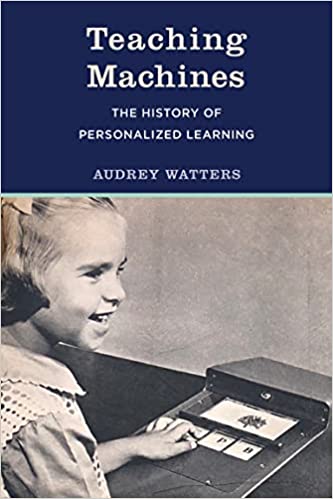You have /5 articles left.
Sign up for a free account or log in.
 Teaching Machines: The History of Personalized Learning by Audrey Watters
Teaching Machines: The History of Personalized Learning by Audrey Watters
Published in August 2021
One of Audrey Watters’s observations in her deeply researched Teaching Machines is that ed-tech evangelists seldom make an effort to learn the history of educational technologies. For those incentivized (ideologically or financially) to place technology at the center of learning, the only relevant time frame is the future.
This unwillingness among ed-tech champions to acknowledge (much less grapple with) what came before is that helpful lessons remain unlearned.
By not contextualizing our work within the long history of technology-centered interventions in teaching and learning, we (and here I am reluctantly counting myself among the tribe of digital learning evangelists) are at risk of misjudging the potential impact and success of our efforts.
In short, knowing some history of educational innovation may cause us to curb our enthusiasms, temper our promises and be aware of our potential to cause harm.
In building a historical and sociological case for the limits of technology to advance learning, Watters rewinds the story to the predigital era.
The teaching machines of today, the MOOCs and adaptive learning platforms, and even our (my) unbridled enthusiasm for scaled online degrees have their roots in a series of analog devices and in the educational ideologies that spawned their inventions.
Long before Khan Academy first emerged in 2008, or the Year of the MOOC was first proclaimed by The New York Times in 2012, the dream of technologically enabled self-paced learning had been dreamed and productized.
Watters carefully tells the stories of predigital learning devices’ inspirations, creations, financing, diffusion and impact.
The story starts with Ohio State professor Sidney L. Pressey and his invention of the Pressey Testing Machine in the 1920s. The narrative continues through the middle of the 20th century, with B. F. Skinner’s creation of his “teaching machine,” built around Skinner’s principles of operant conditioning that came to dominate psychology theory.
It is not possible to overstate the care Watters takes in unpacking the stories of the academics and their corporate partners and foes in telling the history of teaching machines. Watters meticulously tells the stories of Pressey and Skinner and others in their orbit through primary documents, letters, contemporaneous news accounts and other archival materials.
This predigital educational technology story is contextualized within the cultural, political and social milieus in which these inventions (and later business attempts) were conceived and launched.
A central takeaway for anyone working in the education innovation industrial complex (including online learning) is that some of our most “progressive” ideas are, in reality, a good century old.
The notion that education can enjoy the productivity gains of other information industries if only we can apply the right technologies and methods and incentives long predates the invention of the digital computer.
Our faith in the power of self-paced learning, chunked content and frequent low-stakes assessment and feedback would not be out of place in conversations around the midcentury promise of Skinner’s teaching machine.
In Teaching Machines, Watters has provided a sturdy historical foundation for her long-running (and highly influential) skepticism of the efficacy of most educational technologies.
Teaching Machines is a book, and Watters is a scholar, that both deserve a central place in our academic conversations about the future of teaching and learning.
What are you reading?




